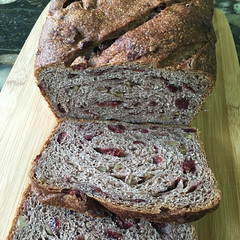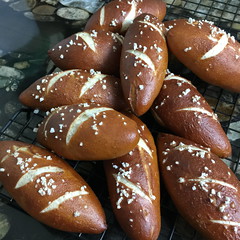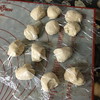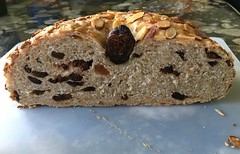 My babka, the weekly Rose's Alpha Bakers recipe, shows both how distracted I am and that you can get away with a good bit of sloppiness and still have a wonderful bread at the end. I set out to bake a half recipe of the babka using the chocolate almond schmear filling. While both the almond and the apricot and cream cheese fillings sounded good, I went with the chocolate because, well, chocolate. Also no cream cheese in the house and not wanting to make a grocery store run.
My babka, the weekly Rose's Alpha Bakers recipe, shows both how distracted I am and that you can get away with a good bit of sloppiness and still have a wonderful bread at the end. I set out to bake a half recipe of the babka using the chocolate almond schmear filling. While both the almond and the apricot and cream cheese fillings sounded good, I went with the chocolate because, well, chocolate. Also no cream cheese in the house and not wanting to make a grocery store run. The bread began, as usual, with a spong. I keep King Arthur bread flour instead of Rose's preferred Gold Medal, but I didn't want to haul down the second flour container and work out the weights for a half-recipe to get just the right protein level blending KA all-purpose and bread flours, and so used all KA bread flour. From Rose's note, I'll have a denser crumb and more browning as a result. The sponge got a bout 2 hours of rising time at room temperature (because I got absorbed on the computer and forgot it), then went into the fridge overnight to build flavor. Mixing the actual dough was a snap in the stand mixer...except I discovered as I set it to rise that I'd omitted the vanilla. I spread the dough out on a pastry mat and kneaded the vanilla in, mostly. The somewhat uneven areas after this activity seemed to disappear in the first rise.
Then the recipe calls for deflating the dough and chilling it so it can be rolled out and shaped. I distractedly assumed there was a second rise before the shaping and gave it one, stretching out the process as the chilling step can't be skipped: the dough is too soft and sticky otherwise.
While the mistaken second rise was on, I made the filling. The chocolate-almond schmear calls for cake crumbs as a primary component. I normally wouldn't have cake or cake crumbs around, though this time I did (or I could have reclaimed the leftovers from next door). However, that cake is a sort-of spice cake flavored with nutmeg and cinnamon. I didn't want nutmeg in my chocolate schmear (though the dark chocolate might have hidden it) so dragged an end of challah from the freezer and made crumbs with that. I figured generic "cake" would have been higher fat and certainly higher sugar than the challah, and of course wouldn't have yeast, but that the real purpose of these crumbs is a carrier for the chocolate and almond paste. I'm sure less sweet would be fine for all of us, and with the butter in the schmear I didn't think the lower fat level will matter either.
 Schmear waiting, it was time to roll out the dough. I skipped flouring the surface and rolled directly on a silicon mat, letting the residual Pam from the rising container give a bit of non-stick help. I couldn't really interpret the proportions instructions in order to work out which direction to halve, so I winged it and made a rough rectangle, spread on the chocolate (couldn't work out which end to leave a wider margin, either), and rolled it up, pressing as I went to try to keep the bread from opening gaps around the filling. I recently bought a 6-cup Bundt pan precisely for doing half recipes, and the roll of babka dough fit in it nicely though without much overlap...guess my rough rectangle should have been a bit wider.
Schmear waiting, it was time to roll out the dough. I skipped flouring the surface and rolled directly on a silicon mat, letting the residual Pam from the rising container give a bit of non-stick help. I couldn't really interpret the proportions instructions in order to work out which direction to halve, so I winged it and made a rough rectangle, spread on the chocolate (couldn't work out which end to leave a wider margin, either), and rolled it up, pressing as I went to try to keep the bread from opening gaps around the filling. I recently bought a 6-cup Bundt pan precisely for doing half recipes, and the roll of babka dough fit in it nicely though without much overlap...guess my rough rectangle should have been a bit wider.
It baked just in 40 minutes, rotated in the oven after 25, got nicely brown on top (I covered it loosely with foil after the first 25 minutes) though maybe a bit light on the bottom. The warm bread got brushed with melted butter (which Rose calls a "butter glaze") to soften the crust.
Result: nice light crumb, good chocolate flavor on the filling, for a winner of a bread. I did have gaps around the filling, so I guess my rolling-and-pressing technique needs some work. The filling also has a tendency to fall out in moist crumbs as you slice the bread and my limited babka experience doesn't tell me if this is typical. The crumbs become an treat for the one doing the slicing....








































